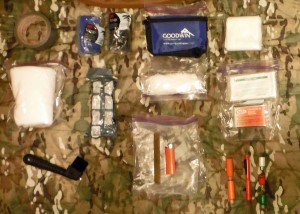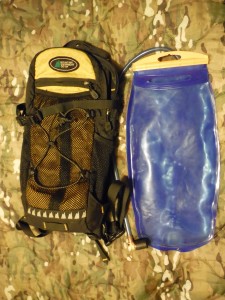Throughout my years of working in the back country, it has always amazed me how many people go into the back country thinking, it’s only a few hours, I don’t need much. Survival in the back country depends on being prepared.
I’ve seen a lot of changes in the back country over the years. Now more than ever, there is easy road access to the outdoors for weekend warriors and top of the line equipment is easily accessible. Manuals are written for just about everything, GPS navigation is inexpensive and the list goes on. The problem is: everything seems accessible and instant, but in the back country a very simple problem can quickly become significant. That’s when the dominoes start to fall.
Consider the following scenario:
It’s a beautiful day to head out to the mountains for some playtime. You grab your horse and tack and decide to head out for the afternoon for a quick ride to your favorite spot. You don’t see a cloud in the sky and its 28C. You grab a light windbreaker just in case, get on your horse and soon are enjoying the peaceful sights, sounds and smells of the forest.
A few hours later and a few extra trails – because you are enjoying yourself so much – you come across a mucky section of trail with lots of deadfall around you. Normally this is not a big deal, but today a moose comes out from nowhere on the trail in front of you. Your horse spins and bolts, knocks you off with the aid of a low hanging branch and gashes its front leg open while running through the deadfall. You land on a fallen log and twisted your knee from your foot not clearing the stirrup. To top it all off, your horse is gone.

Your horse might not have gone far. He may come back, but he knows where the trailer is and might be waiting for you at the trail head.
The problem is that you are15km from the parking lot. At a normal persons walking rate, the walk of shame back to the parking lot would take about four hours, plus you need to hike back up through the mountain pass you had previously been enjoying the view from, so add another hour (*) But you can hardly walk. Now that the adrenaline is settling down you realize your mouth is pasted shut from thirst.
You double check your cell phone for service bars, which are not there, so you grab yourself a stick and slowly start heading back to safety.
It only takes about 1 km of walking in cowboy boots on a rocky or uneven trail for your ankles to feel like putty. Soon blisters start forming on your feet, sending shards of sharp pain with every step you take. You see some water, but it’s the local summer cattle watering hole with lots of manure visible in and around it, so you pass it up, waiting for a cleaner source of water. The sun is now baking your head, and your thirst is so bad you can hardly swallow. You have not even started up the mountain yet. As you work your way back up to the mountain pass in the heat, a massive headache kicks in, and suddenly you feel nauseous and everything starts spinning from heat exhaustion and dehydration setting in. You find a small tree with a sliver of shade and decide to take a rest. Time passes quickly in your weakened state and the hot sun drops behind the mountain. There may be hours of daylight left, but the chill quickly sets in as you sit there resting. You realize you’re not going to make it back before dark.
There are many possible outcomes to this scenario: your horse comes back and you manage to limp your way out, another rider/hiker/mountain biker finds you or you stumble upon a crystal clear mountain creek. Then again it could get worse: rain or snow may set in. Snow and freezing temperatures can occur in the mountains any time of year, even the middle of July.
While you don’t have to pack tons of gear with you, you do need to consider the what if possibilities that this example poses. With some basic survival items most of the life draining scenarios can be avoided.

You need to have a minimum of a knife or multi-tool and a lighter or waterproof matches on your person in case you get separated from your horse. In the summer, consider using a hydration camel water pack and water purification tablets. At a minimum with these items you can build a fire, make a shelter if needed, collect and purify water for hydration.
Your gear doesn’t have to take up a lot of space. Consider this for your saddle horn bags:
On one side: a small equine first aid kit with containing vet wrap(2), cotton padded wrap, a hoof pick, and duct tape (which triples as a temporary boot or an aid to help keep your shelter together).
On the other side: a survival kit containing survival blanket wraps(2), fire starter kit, H2O water purification tablets, toilet paper, triangular bandage, high absorbency trauma dressing and a small human first aid kit. In one of the outside pockets with easy access I carry a pen flare kit with bear bangers and multi colored flares.

I personally never leave home without my trusty Gore-tex jacket, a toque and some gloves – even when it’s hot. It doesn’t take long for the weather to turn nasty in our beloved Rocky Mountains. That said, take extra precautions to keep your gear dry as most saddle bags are water resistant at best. Heavy duty zip lock bags work great, and for those really important items (like toilet paper or your fire starter kit) – double bag it. Trust me on this one: there is no worse feeling when you desperately need an item and it’s soaked!
If your packing won’t pass while standing in the shower, then it won’t pass Mother Nature’s worst weather nor submersion in the water. Also keep your tack in good repair and constantly check important leather straps for cracking or wear.
Your survival in the back country is possible in this scenario, but only if you have properly prepared yourself and your equipment. Always tell someone where you are going and your expected return time. If you are going for longer than a day also leave a brief itinerary on the dashboard of your truck, visible through the windshield. Riding with others provides safety in numbers, however that is not always possible with our busy schedules these days.
Most rides will go off without a hitch, but what about the one that doesn’t go so well? As a professional guide I would always say, It’s not a question of if, but when !
(* Nay Smiths rule of travel for the human is 4km per hour, adding 1 hour for every 1000ft elevation gain).
